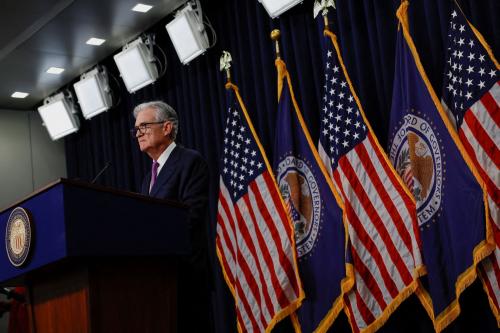This piece was originally published on The Hill.
As someone who worked for decades on poverty in the U.S. before focusing on international development, I find it worth exploring what lessons from the global experience might be relevant to today’s opioid crisis in the U.S.
The opioid crisis is one of the most urgent issues facing America today. Policymakers at multiple levels are making it a priority: President Trump has declared the epidemic a public health emergency, while Congress passed the comprehensive Addiction and Recovery Act last year. Despite this attention, public health officials recently testified before the Senate Health, Education, Labor and Pensions Committee that the crisis is getting worse, not better.
In contrast, the U.S. has enjoyed much success over the past 15 years, on a bipartisan basis, addressing health challenges overseas. Its investments and initiatives have been highly effective in globally reducing child mortality, maternal mortality, malaria, and HIV/AIDS, and its leadership was critical in shutting down Ebola as the disease began to spin out of control in West Africa.
Development is a discipline, and when viewing the opioid epidemic through the lens of practitioners involved in these global efforts, the playbook is not a mystery—and raises the following questions:
What’s the goal?
Clear, time-bound goals based on rigorous analysis of the data are the cornerstone for mobilizing people, money, and action. Analyses of the opioid crisis are awash in statistics: a 493 percent increase in opioid addiction since 2010, a quadrupling of opioid-related deaths since 1999, maps of the breadth and geographic distribution of the epidemic.
Yet, there is no clear, serious articulation—backed up by evidence and analysis—of ambitious yet feasible reductions that the U.S. seeks to achieve, and by when. Why hasn’t the U.S. committed to a goal, such as a 50 percent reduction in addiction and overdoses within five years?
True, developing such measures is not an easy task, and requires informed debate among experts and leaders. There is not even good data or agreement about the extent to which current overdoses are related to prescription opioids. But until the U.S. commits to a clear definition of success, one with a basic level of consensus among key stakeholders, its efforts risk incoherence, and its ability to make swift and sufficient progress will be unnecessarily limited.
What’s the plan?
With a clear, measurable goal in mind, a strategy can then prioritize, sequence and integrate interventions—and even accelerate promising new innovations—for maximum impact. A list of 56 recommendations, the output of the presidential commission, does not a constitute a coherent plan.
The five-point strategy put forth by the Department of Health and Human Services provides more focus, but does not link estimated results to the interventions it proposes; nor does it explain why they were prioritized over others.
Various trade-offs must be weighed. Some interventions might be deployed at scale more quickly; others might have been proven more effective, but cost more; still others might show great promise, but require more testing. It’s crucial to balance the known effects with the unknown, integrate and sequence efforts for maximum impact and commit to credible estimations of the outcomes expected, based on historical data and prior evaluations.
Who’s responsible and for what?
Clear goals and a plan provide the basis for mobilizing action. The president’s pick of Kellyanne Conway as opioid czar has attracted some criticism, but as Ron Klain proved during his management of the Ebola response, the central leader doesn’t have to be a substantive expert to be effective.
What she must do is leverage the authority and political capital of the White House, to coordinate internally and attract serious commitments from stakeholders who matter—key cabinet members, governors, pharmaceutical CEOs, hospitals CEOs, health-care organizations, health professionals, philanthropists, and community nonprofit leaders.
Addressing such a complex and multifaceted epidemic requires the contributions and actions of stakeholders to reinforce each other.
How will we know?
Transparent accountability, to track follow-through on those commitments and progress on ending the epidemic, is central to sustaining momentum over the time period necessary to achieve success. The public should easily be able to access understandable data that is regularly updated to view progress. Such transparency minimizes the guessing game of identifying who’s not keeping up their end of the bargain and what’s not working as planned, and it provides incentives for elevating and scaling what is.
Here is one example of how this has worked: In 2012, the U.S. and partners realized the global community was falling short of an agreed-upon goal under the U.N. to achieve a two-thirds reduction in unnecessary child deaths by 2015. Experts published key trend analyses in the Lancet, and a global coalition of governments, civil society organizations, multilateral agencies and businesses emerged to make new pledges and expand partnerships to accelerate progress. This Call to Action, convened by the U.S., India and Ethiopia in collaboration with the United Nations International Children’s Emergency Fund (UNICEF), prioritized increased efforts in 24 countries that accounted for 80 percent of the under-age-five deaths at the time. It also focused on addressing the top causes that accounted for nearly 60 percent of deaths.
Impact was swift: Over the next two years, it was estimated that an additional 500,000 children’s lives were saved. A publicly accessible data dashboard is still available to view the most recent statistics by country.
Yes, there are substantive and contextual differences between this (and other global health crises) and the opioid epidemic in the U.S. The blueprint for a successful response, however, remains relevant. In fact, the opioid crisis demonstrates the applicability of the U.N.’s Sustainable Development Goals (SDGs) to the U.S. and other developed countries. Prevention and treatment of substance abuse, including narcotics, is one of the targets under SDG 3. U.N. agencies and other multilateral entities have proven the value in driving social progress through this type of goal-setting and mobilization of stakeholders. Indeed, the U.S. has led efforts to hold global institutions to outcome-oriented standards in order to maximize its own return on investment. The country needs to do the same thing at home— across local, state, and federal governments.
To end the opioid epidemic, bipartisan agreement isn’t enough. Political attention isn’t enough. Good intentions aren’t enough. The lessons we’ve learned are clear:
Well-defined, time-bound and evidence-based goals provide the basis; tested and scalable interventions, combined with key innovations, provide the means; coordinated commitments and contributions from a wide array of stakeholders provide the muscle; and transparent reporting and easily accessible updates provide the measure.
Americans know how to “do” goals. President Kennedy practically invented the concept with the moonshot. It’s time to hold ourselves to the same measurable standards we ask of others. Our fellow citizens affected by this crisis deserve no less.




Commentary
Op-edFight opioids with lessons learned from Ebola, HIV crises
December 20, 2017